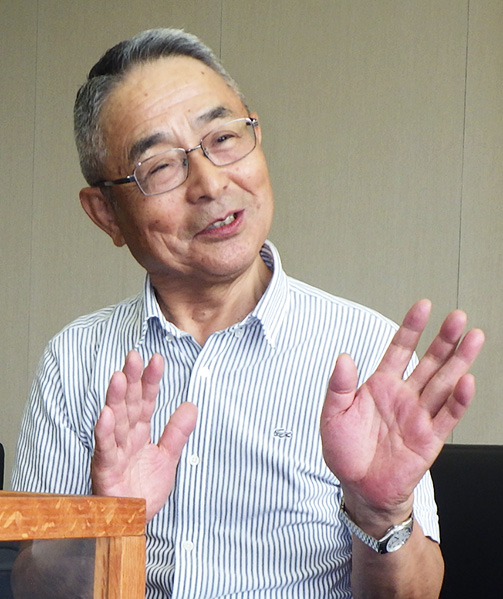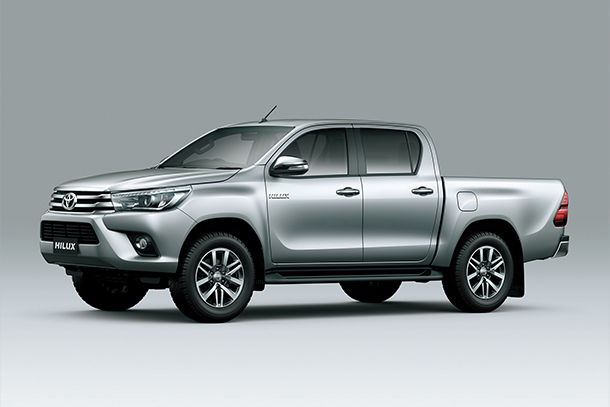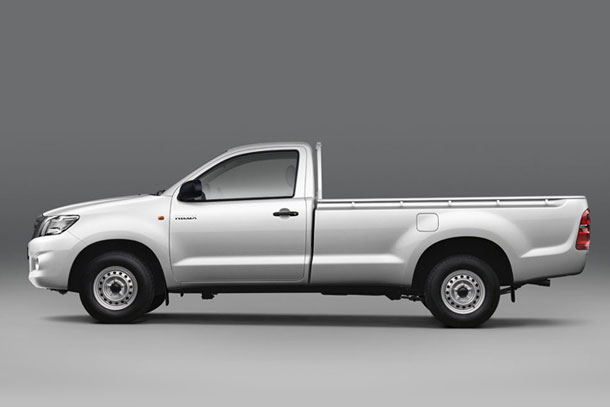Sep. 25, 2018
Shigeo Asai, Chief Engineer for the 5th generation HiluxDeveloping a vehicle that understands the "heart"―the feelings and beliefs―of the countries it is driven in
Having worked on the model since its debut, the Hilux has helped make me the person I am today.
The original Hilux was launched in 1968, five years after I joined Toyota. I was responsible for designing the first-generation chassis frame, which ended up being my first foray into the vehicle's development. Ladder frames had been around for a long time, but welded ladder frames are extremely intricate. Depending on which parts of the frame are welded and the order in which the welds are made, the frames undergo greater or less distortion. Also, the frame properties change between the hot welding stage and the cooling stage. For these reasons, it's important to identify the appropriate specifications through repeated calculations and tests. Once the design is finalized, production employees apply their expertise in concert with the presses and welds created by craftsmen to create a flexible yet strong ladder frame.
For the second-generation model, I was in charge of designing the vehicle's entire suspension. Then, in later years of the second generation and moving into the third generation of the Hilux, I was appointed as one of the key people responsible for the vehicle. I started to look at the Hilux as a whole, and I came to think about what sort of vehicle the Hilux should be. I was then put in overall charge of developing both the fourth and fifth-generation Hilux―my goals were to enhance the vehicle's ability to conquer poor roads, its habitability, its comfort and, at the same time, to create a vehicle that could be driven with enormous pleasure by anyone, at anytime, anywhere in the world.
Team members working on the Hilux have opportunities to go abroad
I believe that the Hilux is one of the vehicles that contributed to Japan's rapid post-war economic growth. Highly versatile, its cargo bed can be loaded with goods and used for work while easily doubling as the ideal vehicle for social outings, and in Japan, businesses have used it for deliveries of fresh produce. The double-cab versions, which came later, can seat four electric company workers with room for tools in the cargo bed, and have also proved useful for workers who need access to mountainous regions to perform maintenance work on transmission towers. The Hilux, exported soon after its launch, is also highly regarded globally, enjoying immense popularity as a solid vehicle, particularly overseas.
At that time, however, it was rare for employees to see first-hand how vehicles were being used overseas; consequently, when I was placed in charge of development, I created an environment that enabled as many members of the development team as possible to go and see how the Hilux was being used overseas. Since it is impossible to replicate local usage conditions on Japanese roads and test courses, I informed the company of my desire to enhance the Hilux by driving it on the roads in the countries in which it was being sold and driven; Toyota allowed me to send test vehicles overseas together with members of the development team, both to better understand Hilux usage scenarios and to create ever-better cars. When news spread that engineers working on the Hilux were permitted to go overseas, my department became one of the most popular in the company.
In terms of sales volumes, at that time the Corolla was Toyota's bestseller, followed by the Hilux. However, since almost 90 percent of Hilux vehicles were sold overseas, its share of domestic sales was comparatively low, and there was limited awareness even among Toyota employees that the Hilux was one of Toyota's flagship models. I worked to ensure that sales volume rankings were included in company newsletters; this led to an increase in awareness of the Hilux and, in turn, led to a number of talented engineers applying to work at our department. In order to strengthen bonds between all employees working on the Hilux―not only the designers, but those involved in production, sales, and even accounting―we went out for meals together and even hosted a softball tournament; aiming to create an environment that encouraged communication, with everyone involved learning to work together. In this way, we pressed ahead in our efforts to create the new model as a united team: a "Team Hilux," as it were. The purpose of these initiatives was not simply for team members to become better acquainted; rather, I wanted to provide them with opportunities to have a frank exchange of opinions.
From my point of view, the technicians from the Vehicle Evaluation & Engineering Division who drove our prototype Hilux were our very first customers. We treated the technicians' evaluations as the "opinions of our customers," and fed those opinions back into the kaizen ("improvement") process.
Refining the Hilux and our human resources overseas
When I went abroad, I realized the Hilux was being used in a completely different way in each country. In the U.S., for example, customers typically owned both a passenger car, such as a sedan, and a pickup truck, using the passenger car during the week and the pickup on the weekend for shopping or outdoor activities like beach outings. The Hilux became part of the unique American "pickup" culture―a vehicle that was neither exclusively a truck nor a passenger car. In Thailand, on the other hand, the Hilux was used like a bus, transporting dozens of people at a time, while in the Middle East, young adults listened to the radio in the air-conditioned interior of the vehicle and otherwise used it as if it were their own private room. In this way, people from various countries around the world taught me how the Hilux could best be put to use.
In central Australia, if it rained even once, the thin red sands would morph into mud that was impossible for 2WD vehicles to negotiate, and it was the same on inclines and in sandy areas. I realized that the Hilux had to become a vehicle capable of catering to a wider variety of conditions. To be a vehicle that could be driven by anyone, at any time, in any place, it would have to be 4WD. It became clear to me that our mission was to create a base Hilux model that possessed enhanced truck functions, while catering to the comfort needs, lifestyles, and roads of countries around the world. Up to that point, the Hilux had been designed as a working person's vehicle; however, I had seen how it was being used by customers both in Japan and overseas. In order to cater to the usage scenarios of an ever-more diverse customer base, I was convinced it was our responsibility to create a vehicle that combined both family use and truck use.
The adoption of 4WD immediately increases the possibilities of the Hilux
Having equipped the Hilux with 4WD, we took it overseas on a promotional tour. However, we chose not to install the body but, instead, leave it as a chassis base with the frame visible. Attired in a suit when we were promoting the 4WD model in Australia, I was advised by local staff to change out of my trousers into something more appropriate, as a 4WD was seen as being an off-road vehicle. I hurriedly went to an outdoor sporting goods shop to buy different clothes. The promotions took place at an outdoor campsite so, looking back, it would have been strange to have shown up in a suit.
As an engineer, the most important thing is to create a solid car; however, promoting the Hilux was also incredibly important as it was an opportunity to communicate the passion we had incorporated into the vehicle, and so we decided to try a variety of new initiatives with our overseas dealers. The Hilux was a vehicle that had embarked on new challenges, both from a functional and a promotional perspective, throughout its lifetime. The Hilux Surf was already gaining in popularity in the U.S. and, seeking to raise awareness of the vehicle in Europe as well, we entered the Hilux into the Paris-Dakar Rally, one of the highest profile rally events at the time.
We also wanted to make it easier to understand that the Hilux was now 4WD. These days, everyone knows what an SUV is; back then, however, such vehicles were known in Japan by a range of different names―perhaps as recreational vehicles (RVs), for example, or multi-purpose vehicles (MPVs). There was no accepted designation, and so it was difficult for consumers to understand exactly what the vehicles were designed to do. For this reason, we decided simply to place a "4WD" badge on the vehicle. We chose not to trademark this; rather, we wanted it to become a generally accepted term for four-wheel drive vehicles that would be used by all automakers. This would of course mean that the term could be used in Japan, but also overseas in countries where English was not spoken. Subsequently, when the "4WS" acronym was used to designate vehicles with front-and-rear-wheel steering, I was extremely glad to see both 4WD and 4WS had become widely accepted terms for the structures they denoted.
Learning from the Land Cruiser
The Land Cruiser was one of the models featured in Toyota's 4WD lineup. With its reliability, durability, and capacity to drive on poor roads, the Land Cruiser enjoyed immense popularity overseas. When driving the Land Cruiser, it was clear that it had not been created through theory alone; instead, it was the result of improvement upon improvement. Taking a moment to address technical aspects, the Land Cruiser's accelerator and clutch response was heavy. There was a reason for this: if the pedals had responded to foot pressure in the same way as a standard vehicle, when driven on poor roads, vibrations could lead to excess pressure being applied to the accelerator, resulting in the vehicle leaping forward in a bunny-hop like manner. In order to prevent such a scenario, the pedal response was dulled. The Land Cruiser was also equipped with a sub-transmission, making it possible to shift between the H-range and L-range. However, the L-range had provided significant amounts of torque, making the engine physically roll. To counter this phenomenon, the pitch of the engine mount support was designed with a wide berth. Then, to enable the Land Cruiser to be driven through water―across rivers, for example―the intake ducts were located as high as possible on the vehicle. In order to minimize the effects of both water and dust, the vehicle was also designed to allow an air-snorkel to be fitted.
Having thoroughly researched the Land Cruiser, we designed the accelerator and clutch of the Hilux to require the minimum possible foot pressure, since we wanted as many people as possible―customers of various sizes, for example―to be able to drive the vehicle. We also took great care with the setup of the power steering. We ensured that the steering was appropriately weighted, and its revolutionary design meant that unexpected powerful shocks from the ground could be successfully absorbed. This is one of the aspects of the Hilux I am most proud of. While enhancing the Hilux' reliability, durability, and capacity to drive on poor roads, we also sought to create a vehicle that provided even greater passenger comfort.
The Hilux earns the respect of the unique pickup culture of the U.S.
Overseas, and particularly in the U.S., pickup trucks had become an indispensable part of people's lives. However, this category of vehicle was used in various ways regionally. On the west coast, young adults used the Hilux for leisure and for driving on desert and rocky roads, while in the central U.S., the Hilux was used as a tool by farmers. To cater to a wide range of uses, we created a large number of variants. As Chief Engineer of the Hilux, I had decided on two things. First, I wanted the Hilux to become a vehicle that understood the "heart"―the feelings and beliefs―of the countries it was driven in; when we created the 4WD Hilux and sold it in the U.S., customers there delighted in the fact that the Hilux was a vehicle that understood the hearts of American consumers, appreciating that it had been designed specifically for the American market. This made me extremely happy. Second, I wanted the vehicle to be instantly recognizable as a Hilux, even from a distance.
As a result of developing the vehicle based on these two policies, in 1989 the fifth-generation Hilux was chosen as the U.S. Truck of the Year. I was delighted: the Hilux had won this award in the U.S., which was the spiritual home of the pickup; plus, this award was recognition of the goals I had set out for the team as Chief Engineer. I had been fortunate enough to work on designing and developing the Hilux from the first to fifth generations. The development staff had faced unceasing challenges and grown together as a team. I am full of gratitude for Team Hilux, with whom I was able to create new wheel tracks for others to follow.
I would also like to express my gratitude to everyone at Toyota's Tahara Plant and at Hino Motor's Hamura Plant, two plants that have nurtured the Hilux, a global vehicle, with the utmost care.
- CE for 5th generation Hilux
- Shigeo Asai
- Apr. 1963
- Joined Toyota Motor Company
- Feb. 1976
- Assistant Chief Engineer, Product Planning Group
- Feb. 1984
- Chief Engineer, Product Planning Group
- Dec. 1993
- Resigned












